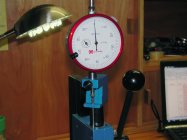T-REX said:
jlow said:
I honestly don’t think there is any significant difference between the K&M and the 21Century. They are both measuring the same thing with the only difference being one is using a direct mechanical linkage and the other a hydraulic one. What does make the biggest difference is the user’s understanding of what to look for. Everyone that starts to use it gets confused in the beginning because they don’t know what to look for since there seems to be so much going on.
Here is a primer:
When you first pull down on the handle, you will feel an increase in pressure – at that point, nothing is really moving significantly as the bullet is pushing down on the case mouth and slowly widening it. That pressure will continue to increase until suddenly you will see it stop increasing even though you are still pulling down on the handle and it is still moving – this is the point when the mouth of the case open and the bullet is entering into the case mouth and this is the pressure value you need to take note of. After this, the bullet will seat fully and as you continue to pull on the handle, the pressure will rapidly rise to max because you are no longer seating the bullet but just pushing against the top of the seater which is steel and will not budge. This part you can also ignore.
That is it.
Do you think you are seeing the difference in static friction (before the bullet starts to move) and kinetic friction (after the bullet is moving) in this process?
How do you think one could differentiate between the two with these setup? I guess one can call the number you get just at the point when the bullet move into the neck as static friction and any changes as the bullet is moving through the neck as kinetic friction.
But generally speaking, this kinetic friction you are speaking of is always much less than the static friction or at least you hope it is and strive to make it so because if the kinetic friction is as much or more than the static friction, your neck would be very rough which is not what you want.
In my own experience, the gauge stays perfectly still as the bullet moves through and that is one way I can ID and get that number.











